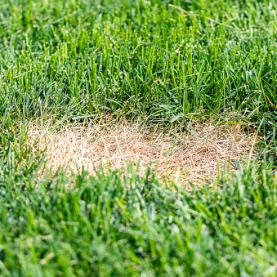
Your Guide To Identifying 5 Common Lawn Diseases
May 01st 2024
Our lawns are important to us. It is where we host parties, relax, and allow our pets and kids to play. Lawns can also be a great source of pride. If you have ever judged a neighbor based on the quality of their grass, you know this to be true. A poorly maintained, unkempt lawn can reflect badly on the homeowner.
Fortunately, Evergreen Lawn Care has come to the rescue. Our Florida lawn maintenance crew is knowledgeable and well-equipped to educate you on best landscaping practices. We are able to provide you with all the information you need to rid your lawn of disease and inhibit the growth of fungi and pathogens. Get your lawn back to its healthy green with Evergreen Lawn Care! Contact us today!
Causes Of Lawn Diseases
Lawn disease occurs when a pathogen comes into contact with your turfgrass. This can cause stunted growth and a change in your lawn's appearance. In Florida, fungi are responsible for most lawn diseases.
To determine if your lawn is experiencing a disease outbreak, inspect it closely, checking for foliage spots or a circular patch that is not consistently green. Any changes in your lawn's color or health should be tackled early, or the disease can progress and spread further into your yard, infecting and killing your turfgrass.
Common Types Of Lawn Disease
Dollar Spot Lawn Disease
Dollar spot disease can be distinguished by its small, circular patches and lesions with brown-colored centers. You may notice these patches are sunken in. Dollar spots usually appear in climates with high humidity and are caused by a fungus that thrives in wet conditions. You can protect your lawn against dollar spots by practicing proper watering and mowing practices.
Brown Patch Fungus
Brown patch fungus may also be referred to as large patch disease. Florida warm-season grasses, such as St. Augustine and Zoysia, can be susceptible to brown patches. Brown patch fungus, like dollar spot disease, is prolific in high humidity. Circular brown and yellow patches characterize this fungus. These patches can sometimes be marked by dark purple or burgundy on the outside. White mycelium from the fungus may be spotted on your grass during dewy mornings. You are likely to notice brown patch fungus in the mid-to-late summer when the grass tends to be warm and wet. Wet grass, whether due to dew, rain, late watering, or inefficient irrigation, all encourage this fungus to develop.
Lawn Rust Disease
Lawn rust can be easy to spot. If the blades of grass on your lawn are yellow and orange or have blisters, you might have lawn rust. The orange will rub off easily when touched. This disease is primarily an issue in the early spring through the fall. Unlike most other lawn diseases, lawn rust is unique in that it thrives in low-nitrogen soil.
Red Thread Fungus
Red thread can affect nearly all turfgrass varieties. It causes reddish-brown patches and pink mycelium to appear in your lawn. While red thread fungus won't kill your grass, it will weaken it. Red thread can make your grass more susceptible to damage from other diseases and insects. It primarily appears in soaked, wet grass.
Fairy Rings
While the name might sound fantastical and mystical, fairy rings can cause great damage to your yard. This disease spreads through your grasses' root system and is marked by a dark green or brown 'ring' appearing in your yard. Mushrooms may also pop up along this ring. Treating fairy rings as soon as possible is important, as the fungus can quickly become a thick layer, preventing your turfgrass from receiving the necessary water and nutrients.
Treating Lawn Disease
When treating lawn disease, it is important to call an experienced lawn care professional, such as the ones with Evergreen Lawn Care! In the case of a fungus, our certified lawn crew can apply the appropriate fungicide to stop the spread of fungal patches.
When treating lawn disease, it is important to call an experienced lawn care professional, such as the ones with Evergreen Lawn Care! In the case of a fungus, our certified lawn crew can apply the appropriate fungicide to stop the spread of fungal patches.
Lawn Disease Prevention
- Preserving your lawn's microbiome is an effective and organic way to prevent lawn diseases. Helpful microorganisms can produce chemicals that inhibit the growth of pathogens.
- Choose a turfgrass variety that is suited for your particular environment or location. Additionally, some grass varieties are more disease-resistant than others. Talk to one of our lawn crew about what turfgrass varieties would be best suited for your backyard.
- Too much nitrogen, soil with a high pH level, and salty soil can all lead to disease. Test your soil regularly, and be sure to use grass fertilizer sparingly and as recommended.
- Wet grass can lead to the formation of many of these diseases and funguses. Avoid watering your grass at night when the blades cannot quickly dry. You should also remove thatch and prune nearby trees and hedges. These simple actions can promote quicker drying and optimize the flow of water, air, and nutrients.
- Sometimes, lawn diseases can be prevented by simply aerating your lawn. This process improves air circulation and stops humidity from accumulating as dew or condensation on your grass blades. Aeration should occur in the late spring or early summer for warm-season turfgrasses.
Gainesville Lawn Maintenance
It can be discouraging to wake up one morning and see your previously beautiful, lush lawn in disrepair. However, most lawn diseases can easily be addressed with the help of our Florida lawn maintenance professionals. We address lawn issues in Gainesville and Jonesville, FL. For a free lawn care estimate, send a request to Evergreen Lawn Care. Our team will quickly respond and deliver the lawn service you need. Contact us today!
